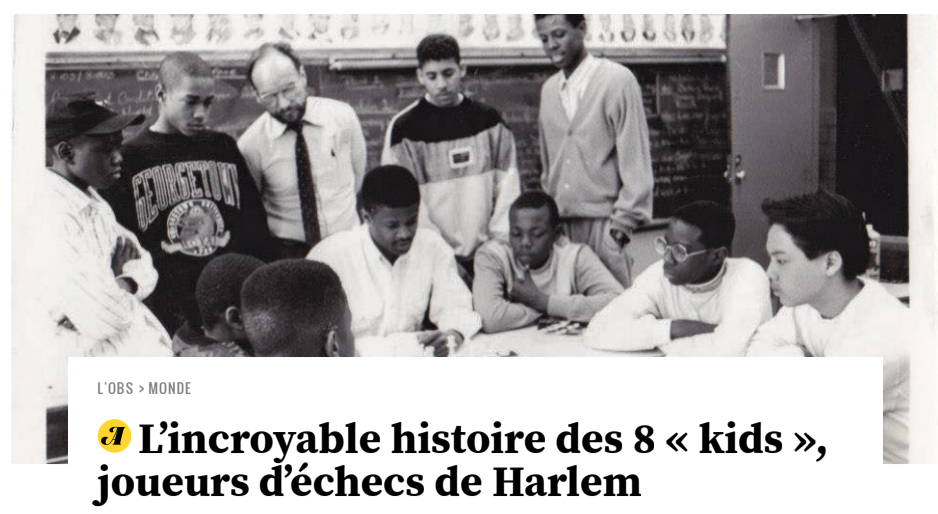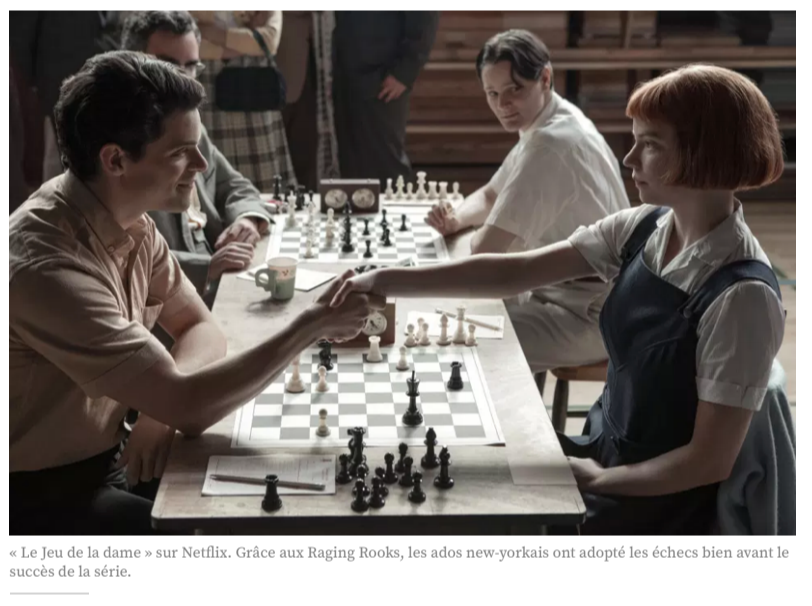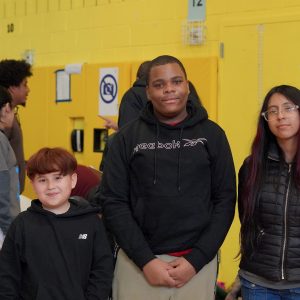
“The Incredible Story of the 8 ‘Kids,’ Harlem Chess Players”
Nothing predisposed these eight kids from the New York ghetto to shine in this “egghead” game to the point of winning the national championship. Apart from a passionate teacher, a charismatic trainer, a colorful sponsor… and a foolproof fighting spirit.
By Philippe Boulet-Gercourt (New York correspondent) • published in French in L’Obs on December 26, 2020 at 11:00 a.m. LINK
A few blocks to reach 129th Street and Adam Clayton Powell Jr. High School in Harlem. It is still early … 7 am. The crack houses are sluggish and armed robberies, stabbings, and murders of all kinds have not yet awakened the neighborhood. On that cold 1991 morning, there were eight of them to converge at high school, eight kids of 13 or 14 who have torn themselves out of bed to arrive an hour before the rest. Not a minute to lose, the chessboard awaits them. In a few months, they will be on the front page of the New York Times, but that they do not yet know. They don’t even dare to dream about it. They just want to play. They are the “Raging Rooks.”

The spirit of the Raging Rooks is still present in New York
Almost thirty years later, their incredible story continues to inspire New York. A few weeks ago, when one of these players died at the age of 43, the Times devoted a long article to him. Charu Robinson, the title of the article announced, “helped change the face of chess in New York.”
Twenty-nine years after winning the United States Championship title and stunning the chic and white world of chess, the kids of Harlem continue to inspire thousands of New York kids from minorities, who today represent 40% of the players in the schools of the city, compared with 10% at the time.
What is the result of such an improbable success? On a shoestring and with small miracles. A science teacher with a heart of gold; a leader of a charismatic chess club, who would later become the first black international grandmaster; a flamboyant sponsor and porn magazine owner; young people with fire in their bellies and an unfailing desire to win. And all this in a discipline for nerds (eggheads), until then practiced exclusively in schools whose tuition alone exceeded the salaries of the parents of these Harlem teens. This game reeked of mothballs, light-years from hip-hop or basketball. Kasaun Henry, future team captain, remembers: “I didn’t know anything about chess, Mr. Collins, a teacher from the school where I had just arrived had given us free time in class at the end of the school year, but he only allowed chess. I looked at these pieces on the chessboard and thought to myself, “What the hell is that nerd thing?” I was absolutely not interested, until a classmate said to me: ‘Get out, you don’t know how to play chess.’ The fact that you can show off with this game intrigued me. And I thought to myself that he could help me integrate into this school.” All of these Harlem kids, thirty years later, tell a similar story: chess came into their lives. By accident.
Getting out of the world of poverty and drugs
Real life was elsewhere, in a neighborhood ravaged by poverty and drugs. Here is how an article described these young people, two months after their victory at the National High School Chess Championship, almost thirty years ago: “Kasaun Henry, the team captain, spent part of the year living in a hotel after the fire in the family apartment. Jonathan Nock was recently held up on the basketball court. Charu Robinson lives near four crack houses. Steven Yow arrived the other day a little nervous to the training session: a drug dealer had chased him in the street, taunting him because he didn’t want to buy drugs.” Kasaun remembers, “For us the choice was every day between conquering this universe or joining it. It was, literally, a matter of survival.” When they got to high school this morning in 1991, the boys sat down in front of the chessboards for an hour. They will take a break for lunch. Six Blacks, a Hispanic, an Asian. The only white present is Richard Gudonsky, the science teacher. He founded the club many years earlier and broods over his recruits like a daddy hen. Maurice Ashley, the professor turned grandmaster, says: “On weekends, he would pick up all his ‘kids’ in his car to take them to Manhattan to play in the tournaments. He would pay for their lunch and bring them home at the end of the day.”
Maurice went to the school twice a week to train the kids at lunchtime. Maurice is not only a gifted chess master, he grew up like those teenagers in the projects, the city’s low-income housing. He remembers: “With me, they had a coach who spoke their language, who had had their experiences, who understood them and could tell them: ‘I can show you something other than this neighborhood, and open a path to success for you… ‘ They climbed on my back and after that we soared.”

One day, the teacher asks young people to choose a name. One of them is “Raging Rooks”. The coach, in this year 1991, has a specific goal: the national championship, which will be held in April in Dearborn, Mich.: “We had finished in the top ten the year before, we could hope to do better.” “For young people, it’s adventure.” Kasaun recalls, “It was my first plane trip. I was super nervous, I took a recording of my mother’s voice to calm me down on the plane.” The trip was sponsored by Bob Guccione, flamboyant owner of Penthouse magazine and philanthropist in his spare time.
A secret weapon, the rage to win
In Dearborn, the kids discover sixty teams facing them. They are eight, just enough to compose two teams of four in two sections, facing the wealthy schools, bringing ten or more. This gives them a huge advantage: only the scores of the best four are retained, which allows bad losses to be dropped. But Harlem’s teens have a secret weapon: the rage to win. Maurice Ashley says: “The upper class kids saw chess more as a hobby among others, like tennis or other chic sports. They didn’t have the same intensity, even though their coaches were great masters. While, for my young people, there was nothing more important than chess.”
After a poor start, the four players in the top section are back in the inferno, with three wins and one draw. Kasaun, in particular, begins his game with a risky opening, the “dragon variant”: “I remember controlling my nerves and setting the stage for countermeasures that allowed me to win the game. It was a very meaningful moment in my life, one of the most profound lessons I have ever learned. I even believe that this was the source of my later attraction to philosophy.”
Luck will do the rest, with the teams ahead of them neutralizing each other. Maurice remembers: “I will never forget when the children tumbled out shouting: ‘We won! We won!’ I couldn’t believe it, I said to them, ‘What are you talking about?”
A few days later, the winning team reunited at Bob Guccione’s kitschy mansion in Manhattan to celebrate their triumph. Kasaun smiles: “Oh my goodness! There was a swimming pool in the house. And while we were in a corner replaying different openings or strategies on a chessboard, a chick showed up, his wife I believe, in an almost transparent dress. We looked at each other in amazement. It was crazy.”
An elitist game became everyone’s game
The story could end there, reduced to a few yellowed press clippings. But that was only the beginning. The victory of the Raging Rooks causes an electric shock. “It was really a foundational event for the development of chess in poor neighborhoods,” notes Jerald Times, chess director for a group of New York schools, who also grew up in Harlem before becoming the one of the five best Black players in the world. He explains, “After their victory, funding for chess programs in these communities became widespread. The Raging Rooks were not just a step in the democratization of chess, they made an elitist game everyone’s game.” Maurice Ashley expands: “You have to realize what that meant, a group of urban ghetto children, who lived in obscene poverty, who were thought to have no potential, were making an extraordinary breakthrough in the most intellectual game of all! It all started with this victory.”
Everything, including being role models and mentors that these Raging Rooks in turn will play. Kwadwo Acheampong, member of the Bronx team that will win the same tournament seven years later said, “They showed us that we can win too. Some of them were our coaches: Charu, Brian, Kasaun… Brian taught me the Smith-Morra, a very sharp opening.”
A formidable Swiss army knife for facing life
Most of these teenagers have experienced spectacular trajectories. Charu Robinson, after landing a degree in criminology, returned to teaching chess, his passion. His friend Michael Propper, owner of the Chess NYC chess school, active in disadvantaged neighborhoods, testifies: “He spoke the language of kids, who respected him. With Charu, they could talk about basketball, sports. Who among them wants to be Bobby Fischer, the crazy genius of failures? Nobody. Who dreams of becoming Klay Thompson, the avid chess Golden Warriors basketball player? Everyone.”
The other Raging Rooks, or their successors, have impressive resumes. Kasaun Henry has three masters degrees and is fluent in five languages: Spanish, Japanese, Ancient Hebrew, Ancient Greek and Latin. Francis Idehen graduated from Yale, has an MBA from Harvard, and is number two in an investment firm. Kwad Acheampong was a trader at Goldman Sachs, manages an investment fund, and sits on the board of directors of a nonprofit dedicated to democratizing chess, Chess in the Schools. And so on.
Chess didn’t make these teens great masters, but they armed them with a formidable Swiss Army knife to face life. Kwad says, “The list of what chess has given me is impressive. Critical thinking, patience, discipline, the ability to analyze, to spot when your opponent is in an awkward position, to develop a strategy… And I wasn’t even one of the best players on the team.”
The history of Raging Rooks demonstrates not just the formative virtues of this discipline. Debbie Eastburn, President of Chess in the Schools, points out: “It also proves that young people, regardless of their social background and family circumstances, are hungry for peer activities. Extracurricular activities may be more important in their lives than what they learn in school. They need these passions to develop their potential.” Due to the Raging Rooks, New York City realized just how much chess can be a springboard. Chess in the Schools helps about fifty schools, thanks to local grants, and the city has many full-time chess teachers.

In the eyes of thousands of New York teenagers, chess didn’t wait for the smash hit of The Queen’s Gambit on Netflix to become cool. But the triumph of The Queen’s Gambit has boosted sales of chessboards across the country, says Maurice Ashley. He reminds us: “Chess has this beautiful ‘indestructible’ side. It has been around for 1,500 years in various forms, and for good reason: it is capable of inspiring new generations.”
Even in the middle of the ghetto.







